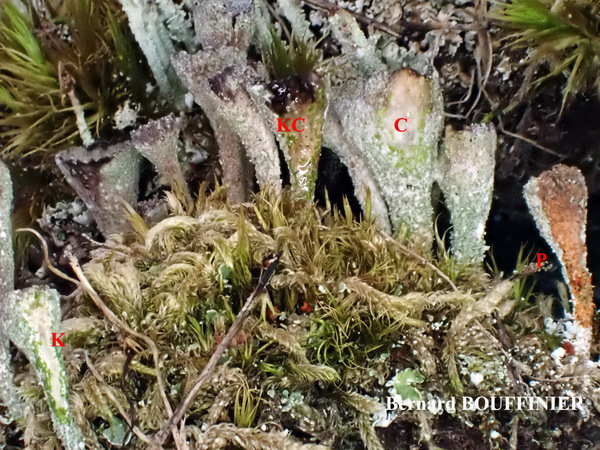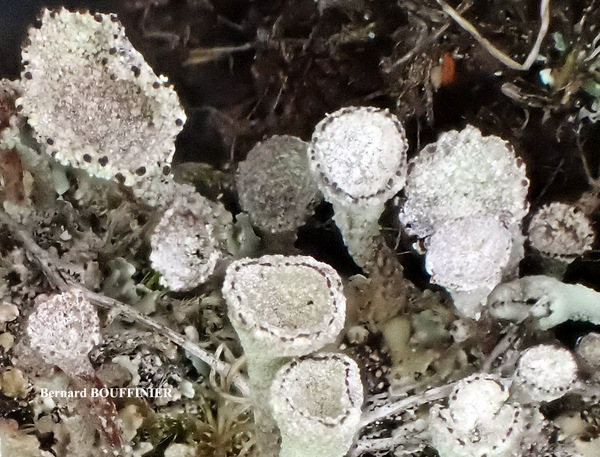Cladonia merochlorophaea Asahina
J. Jap. Bot., 16: 713, 1940.
Synonyms:
Distribution: N - Frl (Tretiach & Hafellner 2000, Tretiach & Molaro 2007), TAA (Zarabska & al. 2009), Lomb (Gheza & al. 2022), Piem (Morisi & Sereno 1995), VA, Lig (Gheza & al. 2020). C - Tosc (Putortì & al. 1999c, Benesperi & al. 2007), Laz (Burgaz & al. 2020), Marc. S - Cal (Puntillo 1996, Burgaz & al. 2020).
Description: Primary thallus squamulose, persistent, the squamules thin, small, ascending, 1-2 mm long, 1-3 mm wide, broadly lobed, greenish grey above, white but turning dark brown to black near the attachment point beneath, esorediate. Podetia goblet-shaped, hollow inside, greenish brown to greenish grey, strongly melanotic at base, usually esquamulose, 0.6-2(-4) cm tall, with 3-9 mm wide, regular or marginally proliferating cups gradually tapering to a short, 1-2 mm thick stalk. Surface of podetia at first corticate-areolate, soon becoming verruculose, the warts giving rise to rough, (20-) 40-80 μm wide granules, schizidia, phyllidia and microsquamules (true soredia absent). Apothecia infrequent, brown, shortly stalked on the margin of cups. Asci 8-spored, clavate, thickened at apex, with a K/I+ blue tholus and a K/I+ strongly blue outer gelatinous sheath, Cladonia-type. Ascospores 1-celled, hyaline, ellipsoid. Pycnidia rare, developing along the margin of cups, pyriform, with a colourless jelly. Conidia hyaline, curved. Photobiont chlorococcoid. Spot tests: K- or rarely K+ yellowish slowly turning brown, C- or C+ reddish, KC+ red in extracts only (microscope!), P+ red or P-, UV+ pale bluish white. Chemistry: chemotype 1) has merochlorophaeic, 4-0-methylcryptochlorophaeic and fumarprotocetraric acids as major and constant substances, chemotype 2) lacks fumarprotocetraric acid.Note: a mainly cool-temperate, probably circumpolar lichen found on humus-rich soil. Distribution, ecology and taxonomic position of this species require further study, and the indicator values are tentative.
Growth form: Fruticose
Substrata: lignum, soil, terricolous mosses, and plant debris
Photobiont: green algae other than Trentepohlia
Reproductive strategy: mainly asexual, by soredia, or soredia-like structures (e.g. blastidia)
Most common in areas with a humid-warm climate (e.g. most of Tyrrenian Italy)
Poorly known taxon in need of further study
Commonnes-rarity: (info)
Alpine belt: very rare
Subalpine belt: rare
Oromediterranean belt: extremely rare
Montane belt: very rare
Submediterranean belt: extremely rare
Padanian area: absent
Humid submediterranean belt: extremely rare
Humid mediterranean belt: absent
Dry mediterranean belt: absent

Predictive model
Herbarium samples
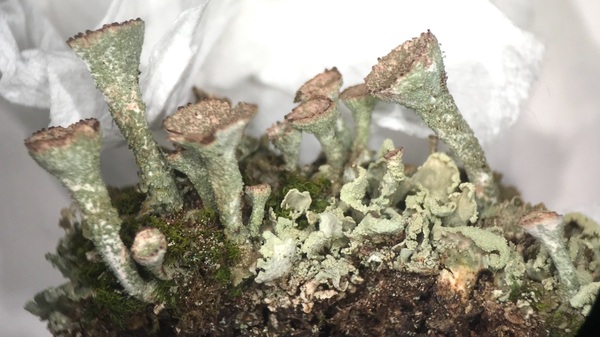
Gabriele Gheza - https://lichenidilombardia.home.blog
Italy, Lombardia, Sondrio, Valdidentro, 1750 m
05/01/2017
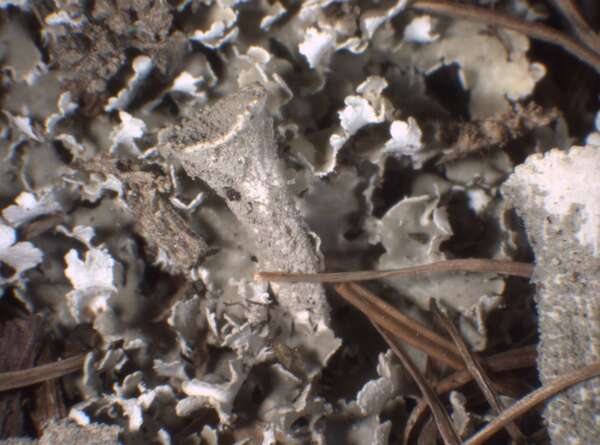

P.L. Nimis; Owner: Department of Life Sciences, University of Trieste
Herbarium: TSB (25111)
2002/12/18
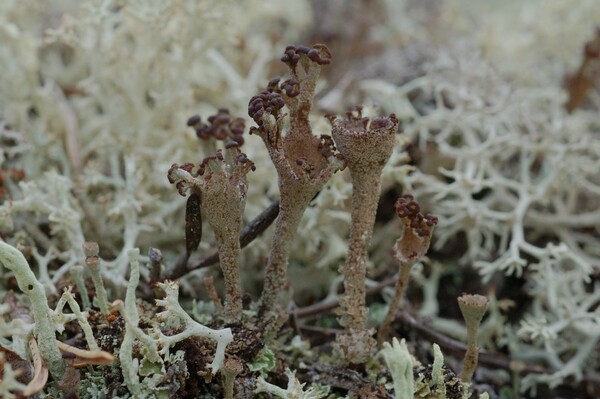
Saxifraga-Willem van Kruijsbergen – Source: http://www.freenatureimages.eu/plants/Lichenes,%20Korstmossen,%20Lichens/Cladonia%20borealis,%20Boreal%20cup%20lichen/
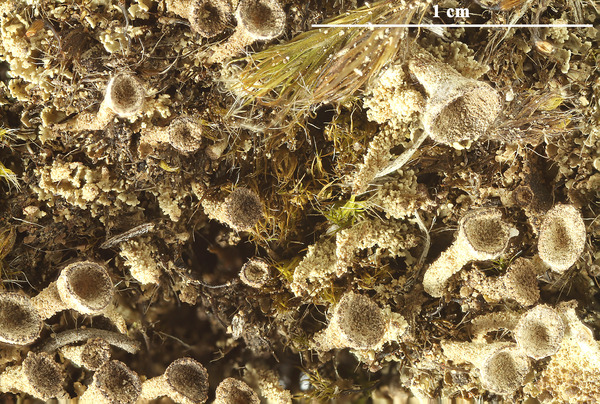

Felix Schumm – CC BY-SA 4.0
[16034], Australia, Australian Capital Territory, Canberra, Black Mountain Reserve, 35.27591° S, 149.09386° E, 760 m. Leg. J.A. Elix, F. Schumm & E. Stocker-Wörgötter, 07.11.2009, det. J.A. Elix.
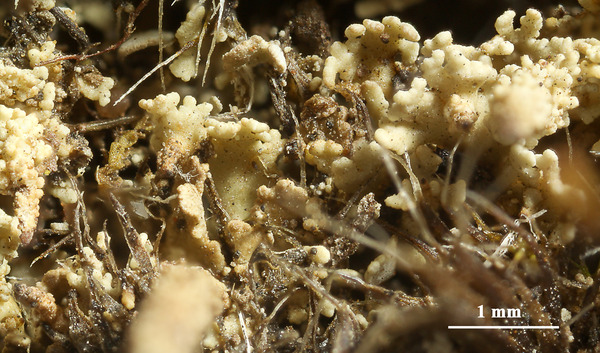

Felix Schumm – CC BY-SA 4.0
[16034], Australia, Australian Capital Territory, Canberra, Black Mountain Reserve, 35.27591° S, 149.09386° E, 760 m. Leg. J.A. Elix, F. Schumm & E. Stocker-Wörgötter, 07.11.2009, det. J.A. Elix.
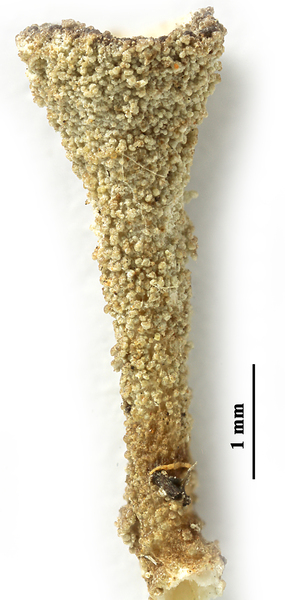

Felix Schumm – CC BY-SA 4.0
[16034], Australia, Australian Capital Territory, Canberra, Black Mountain Reserve, 35.27591° S, 149.09386° E, 760 m. Leg. J.A. Elix, F. Schumm & E. Stocker-Wörgötter, 07.11.2009, det. J.A. Elix.
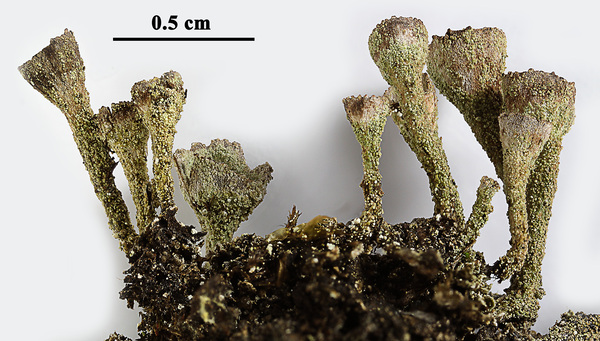

Felix Schumm – CC BY-SA 4.0
[19469], Germany, Hessen, Amöneburg bei Marburg, sonnige Basaltblöcke in einer Hangwiese kurz vor dem Ortseingang, 50.7896° N, 8.91995° E, 324 m. Leg. F. Schumm, 01.08.2016, det. F. Schumm


Felix Schumm – CC BY-SA 4.0
[19469], Germany, Hessen, Amöneburg bei Marburg, sonnige Basaltblöcke in einer Hangwiese kurz vor dem Ortseingang, 50.7896° N, 8.91995° E, 324 m. Leg. F. Schumm, 01.08.2016, det. F. Schumm
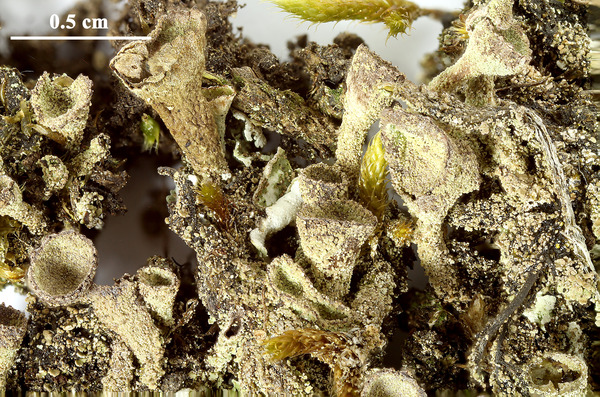

Felix Schumm – CC BY-SA 4.0
[19469], Germany, Hessen, Amöneburg bei Marburg, sonnige Basaltblöcke in einer Hangwiese kurz vor dem Ortseingang, 50.7896° N, 8.91995° E, 324 m. Leg. F. Schumm, 01.08.2016, det. F. Schumm
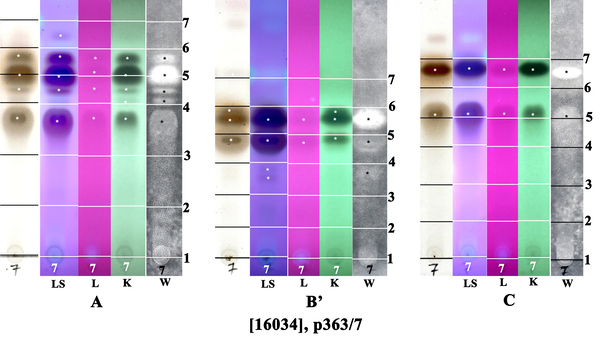

Felix Schumm – CC BY-SA 4.0
[16034], Australia, Australian Capital Territory, Canberra, Black Mountain Reserve, 35.27591° S, 149.09386° E, 760 m. Leg. J.A. Elix, F. Schumm & E. Stocker-Wörgötter, 07.11.2009, det. J.A. Elix.,
280 Cladonia merochlorophaea 1: 4-O-methylcryptochlorophaeic acid, 2: merochlorophaeic acid, 4: cryptochlorophaeic acid, 3: 2,4-di-O-methylnorsekikaic acid; conf. J.A. Elix.
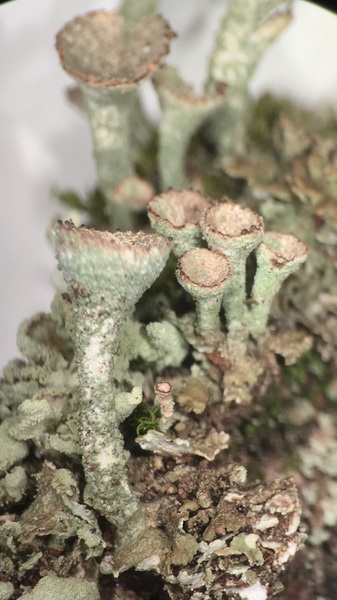
Gabriele Gheza - https://lichenidilombardia.home.blog
Italy, Lombardia, Sondrio, Valdidentro, 1750 m
05/01/2017
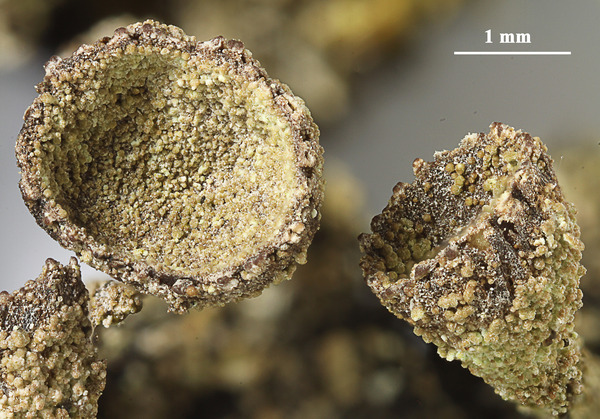

Felix Schumm – CC BY-SA 4.0
[19469], Germany, Hessen, Amöneburg bei Marburg, sonnige Basaltblöcke in einer Hangwiese kurz vor dem Ortseingang, 50.7896° N, 8.91995° E, 324 m. Leg. F. Schumm, 01.08.2016, det. F. Schumm

Bernard Bouffinier- Source: http://www.lichensmaritimes.org/index.php?task=fiche&lichen=1202&lang=en
France, Menez, Meur
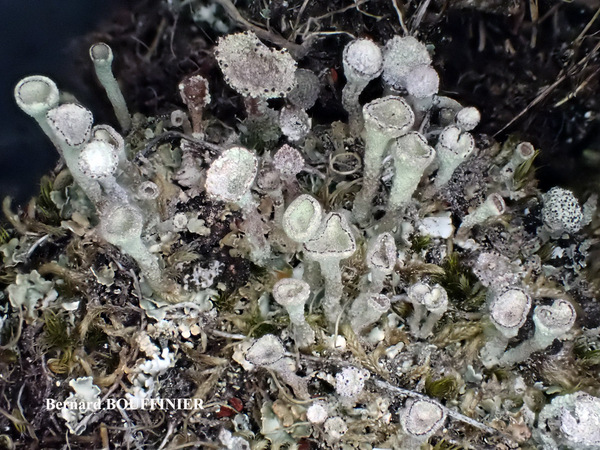
Bernard Bouffinier- Source: http://www.lichensmaritimes.org/index.php?task=fiche&lichen=1202&lang=en
France, Menez, Meur
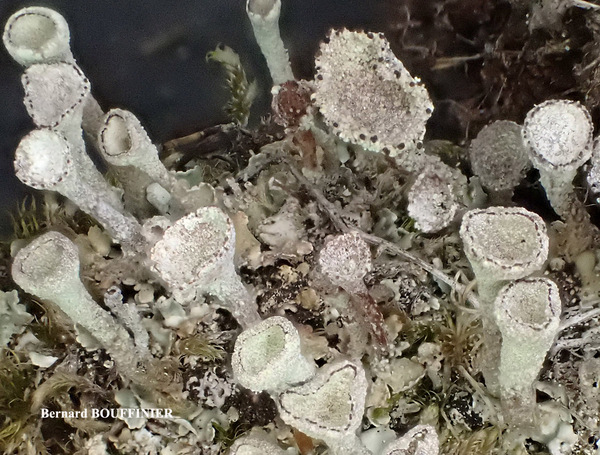
Bernard Bouffinier- Source: http://www.lichensmaritimes.org/index.php?task=fiche&lichen=1202&lang=en
France, Menez, Meur
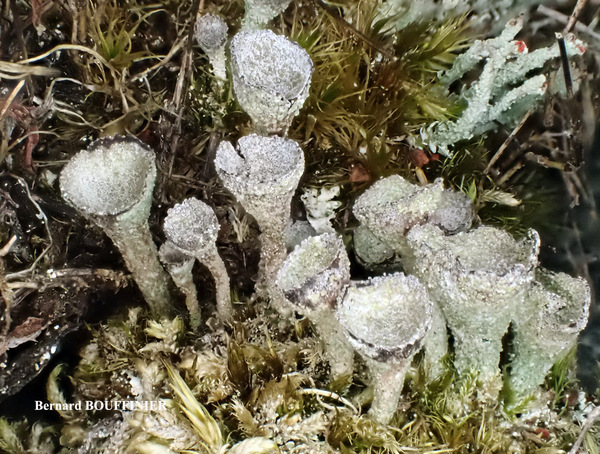
Bernard Bouffinier- Source: http://www.lichensmaritimes.org/index.php?task=fiche&lichen=1202&lang=en
France, Menez, Meur
Growth form: Fruticose
Substrata: lignum, soil, terricolous mosses, and plant debris
Photobiont: green algae other than Trentepohlia
Reproductive strategy: mainly asexual, by soredia, or soredia-like structures (e.g. blastidia)
Most common in areas with a humid-warm climate (e.g. most of Tyrrenian Italy)
Poorly known taxon in need of further study
Commonnes-rarity: (info)
Alpine belt: very rare
Subalpine belt: rare
Oromediterranean belt: extremely rare
Montane belt: very rare
Submediterranean belt: extremely rare
Padanian area: absent
Humid submediterranean belt: extremely rare
Humid mediterranean belt: absent
Dry mediterranean belt: absent

Predictive model
| Herbarium samples |

Gabriele Gheza - https://lichenidilombardia.home.blog
Italy, Lombardia, Sondrio, Valdidentro, 1750 m
05/01/2017


P.L. Nimis; Owner: Department of Life Sciences, University of Trieste
Herbarium: TSB (25111)
2002/12/18

Saxifraga-Willem van Kruijsbergen – Source: http://www.freenatureimages.eu/plants/Lichenes,%20Korstmossen,%20Lichens/Cladonia%20borealis,%20Boreal%20cup%20lichen/


Felix Schumm – CC BY-SA 4.0
[16034], Australia, Australian Capital Territory, Canberra, Black Mountain Reserve, 35.27591° S, 149.09386° E, 760 m. Leg. J.A. Elix, F. Schumm & E. Stocker-Wörgötter, 07.11.2009, det. J.A. Elix.


Felix Schumm – CC BY-SA 4.0
[16034], Australia, Australian Capital Territory, Canberra, Black Mountain Reserve, 35.27591° S, 149.09386° E, 760 m. Leg. J.A. Elix, F. Schumm & E. Stocker-Wörgötter, 07.11.2009, det. J.A. Elix.


Felix Schumm – CC BY-SA 4.0
[16034], Australia, Australian Capital Territory, Canberra, Black Mountain Reserve, 35.27591° S, 149.09386° E, 760 m. Leg. J.A. Elix, F. Schumm & E. Stocker-Wörgötter, 07.11.2009, det. J.A. Elix.


Felix Schumm – CC BY-SA 4.0
[19469], Germany, Hessen, Amöneburg bei Marburg, sonnige Basaltblöcke in einer Hangwiese kurz vor dem Ortseingang, 50.7896° N, 8.91995° E, 324 m. Leg. F. Schumm, 01.08.2016, det. F. Schumm


Felix Schumm – CC BY-SA 4.0
[19469], Germany, Hessen, Amöneburg bei Marburg, sonnige Basaltblöcke in einer Hangwiese kurz vor dem Ortseingang, 50.7896° N, 8.91995° E, 324 m. Leg. F. Schumm, 01.08.2016, det. F. Schumm


Felix Schumm – CC BY-SA 4.0
[19469], Germany, Hessen, Amöneburg bei Marburg, sonnige Basaltblöcke in einer Hangwiese kurz vor dem Ortseingang, 50.7896° N, 8.91995° E, 324 m. Leg. F. Schumm, 01.08.2016, det. F. Schumm


Felix Schumm – CC BY-SA 4.0
[16034], Australia, Australian Capital Territory, Canberra, Black Mountain Reserve, 35.27591° S, 149.09386° E, 760 m. Leg. J.A. Elix, F. Schumm & E. Stocker-Wörgötter, 07.11.2009, det. J.A. Elix.,
280 Cladonia merochlorophaea 1: 4-O-methylcryptochlorophaeic acid, 2: merochlorophaeic acid, 4: cryptochlorophaeic acid, 3: 2,4-di-O-methylnorsekikaic acid; conf. J.A. Elix.

Gabriele Gheza - https://lichenidilombardia.home.blog
Italy, Lombardia, Sondrio, Valdidentro, 1750 m
05/01/2017


Felix Schumm – CC BY-SA 4.0
[19469], Germany, Hessen, Amöneburg bei Marburg, sonnige Basaltblöcke in einer Hangwiese kurz vor dem Ortseingang, 50.7896° N, 8.91995° E, 324 m. Leg. F. Schumm, 01.08.2016, det. F. Schumm

Bernard Bouffinier- Source: http://www.lichensmaritimes.org/index.php?task=fiche&lichen=1202&lang=en
France, Menez, Meur

Bernard Bouffinier- Source: http://www.lichensmaritimes.org/index.php?task=fiche&lichen=1202&lang=en
France, Menez, Meur

Bernard Bouffinier- Source: http://www.lichensmaritimes.org/index.php?task=fiche&lichen=1202&lang=en
France, Menez, Meur

 INDEX FUNGORUM
INDEX FUNGORUM
 GBIF
GBIF
 DOLICHENS
DOLICHENS
